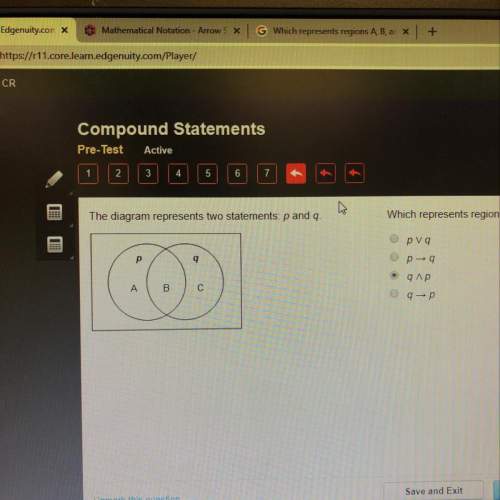
Mathematics, 26.02.2021 23:00 wolfgirl48
Eon verified that the side lengths 21, 28, 35 form a Pythagorean triple using this procedure.
Step 1: Find the greatest common factor of the given lengths: 7
Step 2: Divide the given lengths by the greatest common factor: 3, 4, 5
Step 3: Verify that the lengths found in step 2 form a Pythagorean triple: 3 squared + 4 squared = 9 + 16 = 25 = 5 squared
Leon states that 21, 28, 35 is a Pythagorean triple because the lengths found in step 2 form a Pythagorean triple. Which explains whether or not Leon is correct?
Yes, multiplying every length of a Pythagorean triple by the same whole number results in a Pythagorean triple.
Yes, any set of lengths with a common factor is a Pythagorean triple.
No, the lengths of Pythagorean triples cannot have any common factors.
No, the given side lengths can form a Pythagorean triple even if the lengths found in step 2 do not.

Answers: 2


Another question on Mathematics

Mathematics, 21.06.2019 13:00
(98 points) i need with 5 questions. answer definitions are welcomed, but not necessary.
Answers: 3

Mathematics, 21.06.2019 22:00
Rewrite 9 log, x2 in a form that does not use exponents. 9log, x = log, x
Answers: 3

Mathematics, 21.06.2019 23:00
Ineed to know the ordered pairs for this equation i need the answer quick because it’s a timed test
Answers: 3

Mathematics, 22.06.2019 02:50
If $190 is invested at an interest rate of 11% per year and is compounded continuously, how much will the investment be worth in 4 years? use the continuous compound interest formula: a = pert
Answers: 2
You know the right answer?
Eon verified that the side lengths 21, 28, 35 form a Pythagorean triple using this procedure.
Step...
Questions

Mathematics, 01.08.2019 08:30

Mathematics, 01.08.2019 08:30


Mathematics, 01.08.2019 08:30

Mathematics, 01.08.2019 08:30


Biology, 01.08.2019 08:30

English, 01.08.2019 08:30




Business, 01.08.2019 08:30

History, 01.08.2019 08:30

Social Studies, 01.08.2019 08:30

Mathematics, 01.08.2019 08:30


Physics, 01.08.2019 08:30

French, 01.08.2019 08:30

Mathematics, 01.08.2019 08:30




